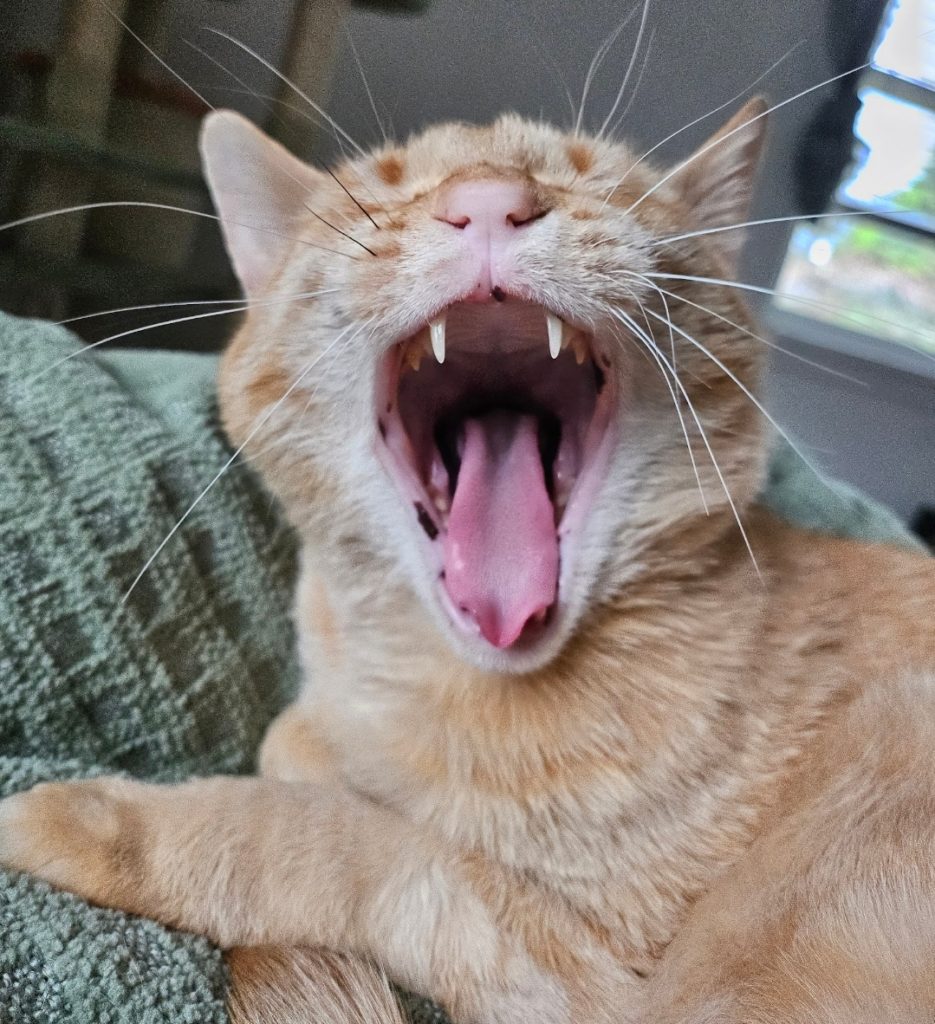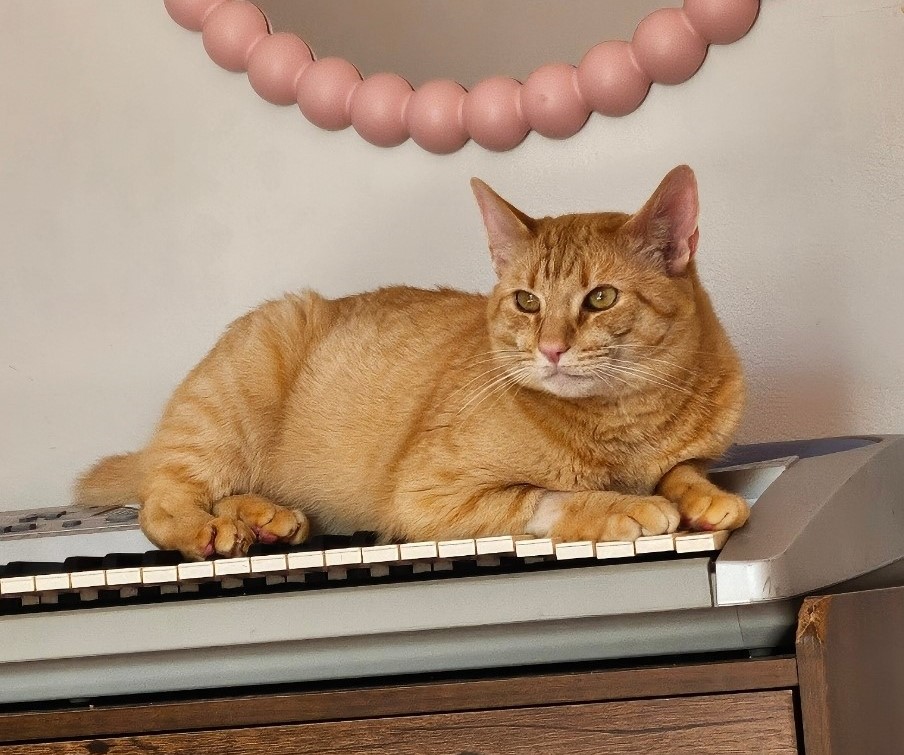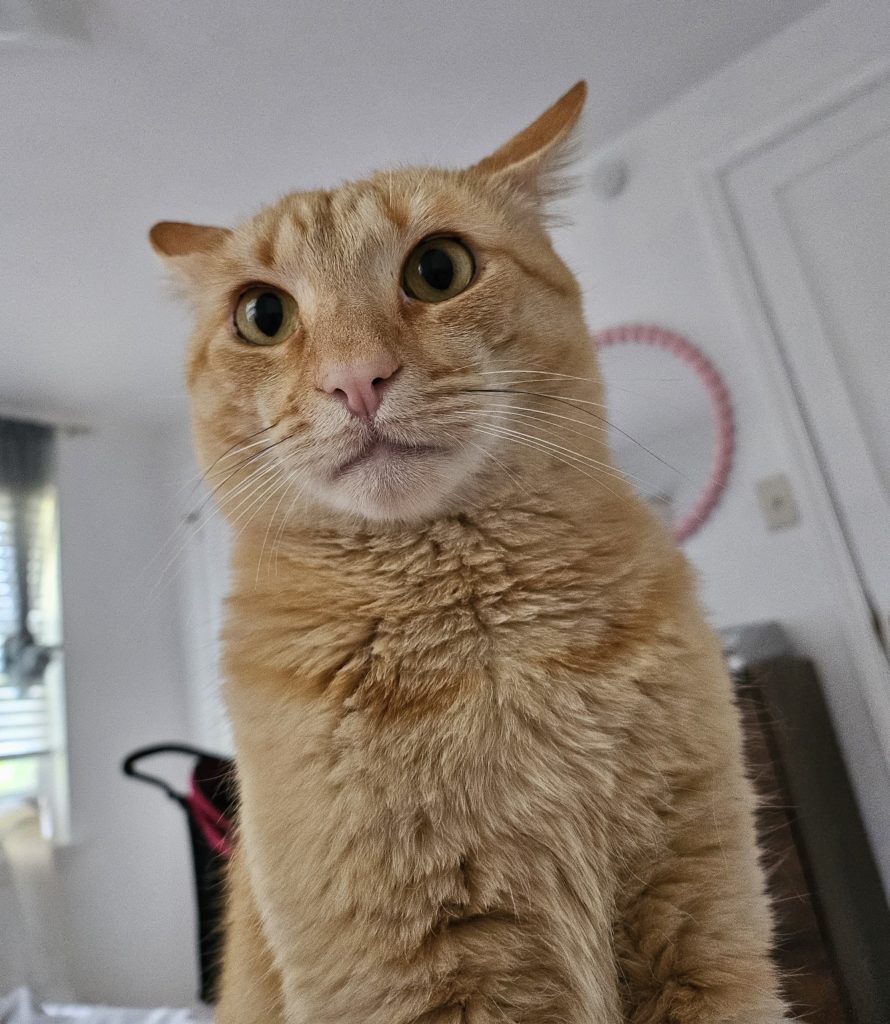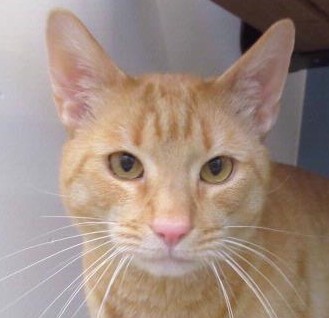
This time for our Pet of the Month we are sharing the story of a special cat named Caspian and his very dedicated owner who is determined to give him the best possible care.
Caspian is a four-year-old orange male cat who is special. He has experienced a number of health issues and hospital visits already in his young life. Thanks to his owner’s vigilance, love, and patience, this resilient boy received proper medical care in a timely manner and has been able to pull through everything.
Among his other health issues, we are going to discuss a heart disease called ‘unclassified cardiomyopathy’ which he was diagnosed with in December last year. We started providing care for Caspian in October 2023. During one of his appointments, we noted his heart rate was less than what we would expect in a cat in a clinical setting. The normal heart rate for cats can be anywhere from 120- 220 beats per minute. In the exam room more than 130 beats per minute is what we typically count. Caspian’s heart rate was 120. This was persistent in the subsequent visits with us and at the ER.
Again, a low heart rate could be normal for Caspian, but other reasons to have low heart rate in cats include:
- High vagal tone – is one of the common causes of low heart rate in cats. The vagus nerve is one of 12 cranial nerves in the body involved in many processes including the heart rate. Increased vagal tone may result from any respiratory or gastrointestinal diseases.
- Hypothyroidism – low functioning thyroid. It is not very common in cats.
- Exposure to certain drugs or toxins affecting the cardiovascular system.
- Problems with the heart’s conduction system.
- Cardiomyopathies – which means disease associated with heart muscle. It is rare to see low heart rate in cats in initial stages but more common in later stages when heart is failing.
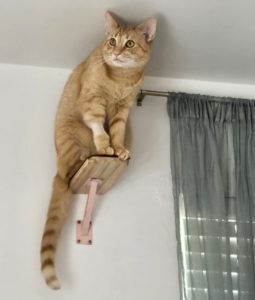 Cats with low heart rate often do not have any symptoms and no therapy is indicated in asymptomatic cases. When present the clinical signs include weakness, lethargy, and syncope.
Cats with low heart rate often do not have any symptoms and no therapy is indicated in asymptomatic cases. When present the clinical signs include weakness, lethargy, and syncope.
Caspian’s owner did mention some days he is not very active, lethargic. While discussing with his owner, we told her that it could be normal, or there might be something underlying and we need additional diagnostics to uncover. Caspian’s owner was on board with all the testing and wanted to get as much information as we can regarding his health. We also discussed the slightest possibility of Addison’s disease which is very rare in cats (more common in dogs) but Caspian’s owner said yes to the test.
The diagnostics to know the cause of low heart rate include electrocardiogram (ECG or EKG) to check heart’s rhythm, complete blood count, blood chemistry, ultrasound to look for any disease condition, X-rays of the chest to assess heart size and a cardiac evaluation by a veterinary cardiologist which includes echocardiography ( ultrasound of the heart).
- During Caspian’s recent trip to the ER, he had ECG and chest X-rays and abdominal ultrasound. Those all looked within normal limits except for low heart rate on ECG.
- Abdominal Ultrasound at the ER was unremarkable
- We tested Caspian for Addison’s disease; there was no indication of the disease based on the test.
- The complete blood count, chemistry screen was all normal including the thyroid level.
At the same time Caspian was scheduled to see the mobile Cardiologist at our facility. On his evaluation diminished heart function was noted meaning his heart was not able to contract normally to pump blood, although the overall size of the heart and its chambers was normal. Based on the above findings he was diagnosed with unclassified cardiomyopathy.
As described above cardiomyopathy refers to primary diseases of the heart muscle (myocardium). The following classes of cardiomyopathies have been described in cats.
- Hypertrophic Cardiomyopathy (HCM) – This is the most common cardiomyopathy which is characterized by thickening of the left ventricular myocardium which puts them at risk of developing heart failure and clot formation.
- Restrictive Cardiomyopathy (RCM) – This is caused by development of scar tissue on the muscle of the heart ventricle that prevents it from relaxing completely, filling adequately, and emptying appropriately with each heartbeat. This impairs the heart’s ability to pump blood and oxygen to the body similarly to HCM.
- Dilated Cardiomyopathy (DCM) -This condition is characterized by a dilated (enlarged), thin-walled left ventricle that cannot generate sufficient pressure to eject blood when it contracts. Cats with DCM are similarly at risk for the development of heart failure. It is important to note that DCM is commonly caused by a dietary deficiency of taurine, an amino acid. Commercial cat food is now supplemented with taurine so incidence of DCM is rare. But cats fed raw/home cooked diets are at risk of developing taurine deficiency.
- Unclassified Cardiomyopathy – includes all those cardiomyopathies that do not fit any of the previous descriptions and the cause is not well established.
Caspian was eating a grain-free diet that contains chickpeas. The cardiologist did mention this may be contributing to, or causing, his decreased heart contractility. By that time, we had already started him on a well-balanced prescription diet and later needed to change to another prescription food that also addressed his urinary symptoms. The cardiologist also advised supplementing Caspian’s diet with Taurine and re-evaluate in 6 months.
At Caspian’s recheck appointment and repeat echocardiography the previously noted unclassified cardiomyopathy appeared resolved. It was noted that his heart size/structure still looks normal with normal function this time. So, Caspian responded to the diet change and taurine supplementation; it was strongly suspected that his heart condition was related to the food he had been eating.
It was such a good news for both Caspian and his owner. They both deserved to celebrate this victory. We recommended keeping him on a well-balanced grain-inclusive diet for the rest of his life.

